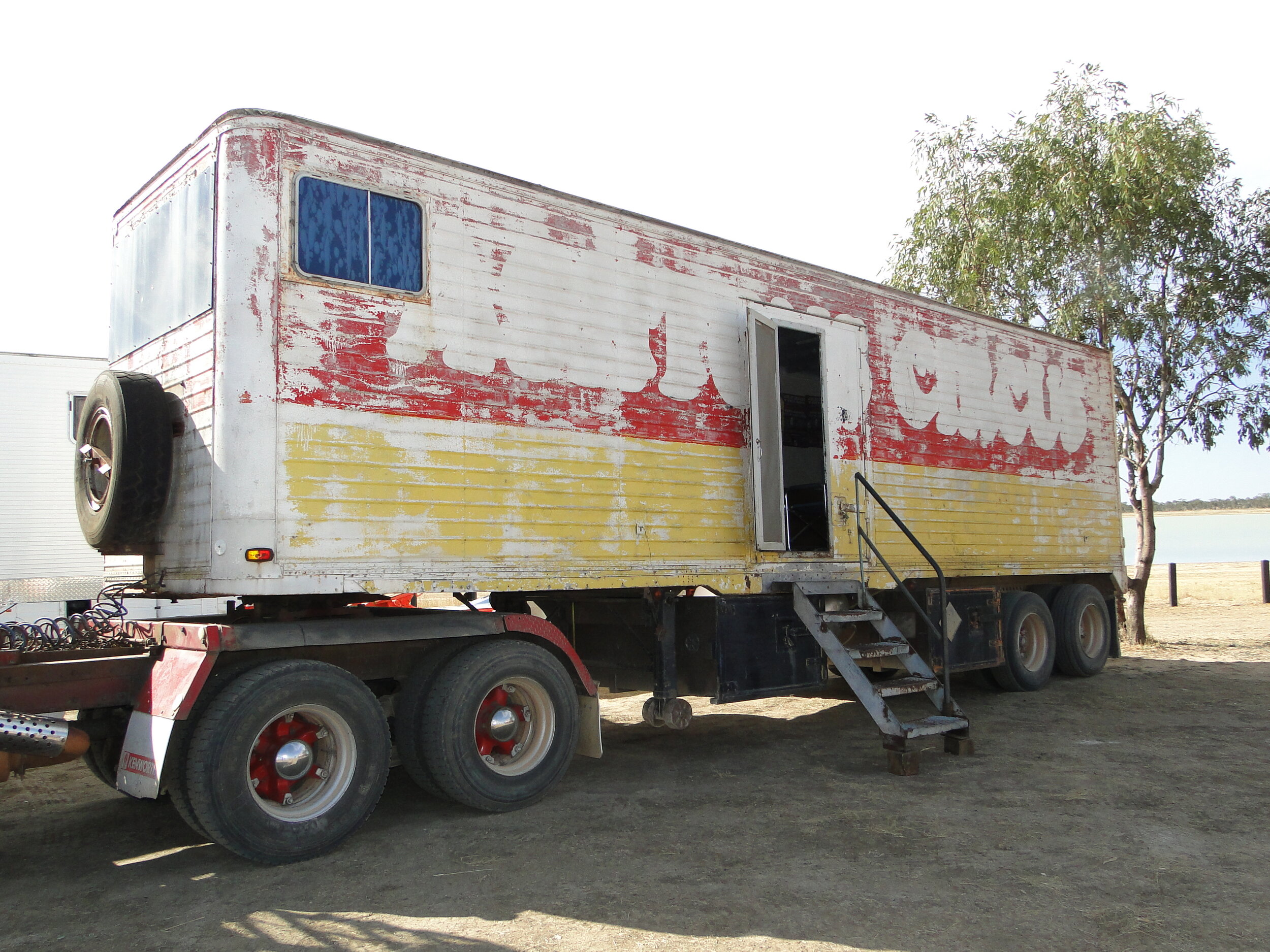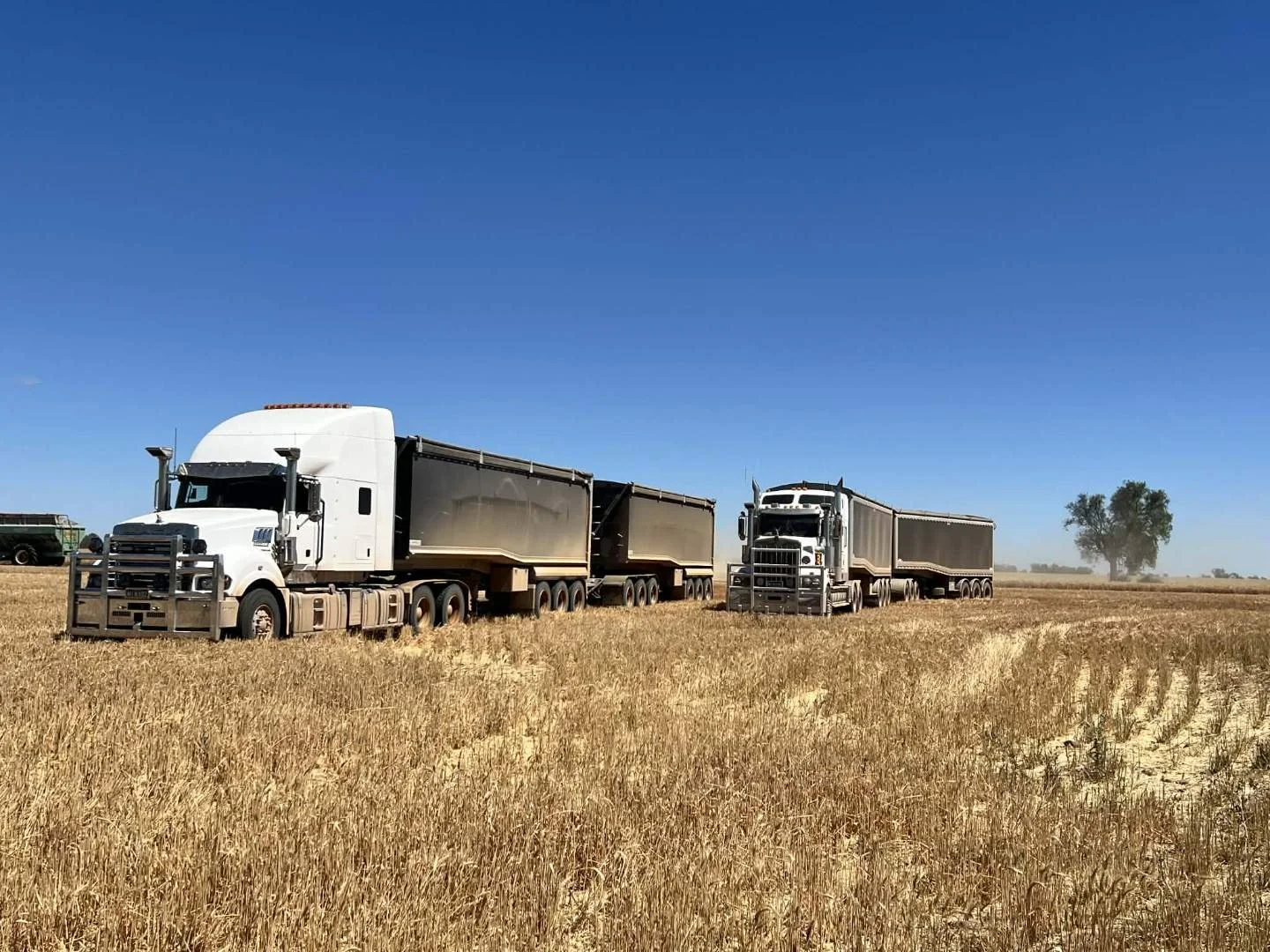Living in the Lion’s Den
Sitting behind a battle scarred 1987 W-model Kenworth sits an equally old and scarred refrigerated van, now minus its cooling equipment. Upon closer inspection, I can make out the original signage down its flanks. It proudly proclaims that the trailer once belonged to Ashtons Circus, a name familiar to most Australians. Being a Reefer, the trailer obviously carried meat, presumably for the Lions that featured in the day.
Today the trailer (and the W-model) are owned by Cleve Thiele. The van was bought for Cleve and friends to go to Alice Springs and the Trucking Hall of Fame Reunion in 2010, a trip she has since repeated.
Replacing the Lions lunch, the van now sports an old but comfortable fold-out couch featuring armrests that were originally W-model air horns (“Thanks to Paul Dossett.”), a shower, a more than decent fridge (“It’s long way to Alice.”), four bunks, a pot-belly stove, and in a stroke of design genius, a dining area come lounge room above the 5th wheel.
With one way glass in front and on both sides, this elevated lounge offers scenic views over the roof of, and around the ‘W’. If I were to be a passenger on a trip to Alice, this is where I’d like to spend it! The view is akin to those Canadian trains that traverse the Rocky Mountains.
Dining come mezzanine lounge
'Privacy' glass offers panoramic views over the W's roof.
“She’s here for like-minded people to come along. I get a kick out of others getting enjoyment out of it,” says Cleve. “I’m a public service. It’s provided a safe haven for lots of people on lots of occasions.
The ‘Lion’s Lunch’ Pantech has seen up to 40 bodies (live ones, that is) in it and that pot-belly stove has driven its occupants out into the driven snow at times. “Sometimes it’s just too bloody hot to come in here. I’ve stood out in the pouring rain in preference sometimes. At Goldsmith one time, we were all in singlets outside the van. People freezing outside couldn’t understand why we were ripping our clothes off.”
Along with the van’s insulation, the pot-belly sometimes works too well
The outside of the van displays its Ashtons Circus heritage and Cleve won’t touch it. “Like the ‘W’, she’s what she is, warts and all. How many people can claim to having shared space in a Lion’s Den?”
An old air cleaner makes a great bikkie bin
…..
Now 62, Cleve grew up on a Sawmill in Avoca. “We logged out of the forest into the mill then on to market, mainly Melbourne. The mill got burnt out in 1985 so I went to work in the Wombat Forest in the Daylesford area.
“We eventually set up another mill but before we finished it we sold it to another in Daylesford and contracted to do their logging. They ended up in a syndicate of 13 different mills so we continued with that which increased business substantially.
“At that stage pulpwood started up so the rubbish in the forest went to Geelong for woodchip, which this country sold for next to nothing and bought back from Japan for a lot of money. We had four of our own trucks (three Kenworth and one Mack), 4 excavators, 4 skidders and a crew of around 13. That went on for thirteen years until the government it in its wisdom decided to close the forest down. That was a bit of a sore point. We have huge problems with plastic bags clogging the ocean, drains and all, whereas we used to make things out of timber, such as paper bags. It was all biodegradable and naturally renewable.”
Was thought given to regenerating the forest back then?
“We rarely clear-felled. When you take a Eucalypt hardwood tree out, nature replaces it with three to four trees. It’s natural regeneration. If you fell judiciously, you can come back in ten to fifteen years and fell again. The only problem early on was that without the pulp industry, we couldn’t take the bad trees because we didn’t have a market for them. When the pulp came in you took those trees as well, so the forest regenerated even better. It made more room for the new forest to grow with better quality. We didn’t harvest the forest to put it into extinction. We harvested it so we could come back and do it again and again…”
“Now we use plastics, concrete, steel, aluminium, which takes without giving back. Concrete is something like 300 times more energy demanding to produce a building than timber and it never replaces itself.”
Like many of his age, Cleve Started before he had a licence. “I remember driving a dozer at 6 to get the old man out of a bog.
“When I got behind the (truck) wheel, if the truck did the job I didn’t mind what brand it was. I went more for KW - GM and Cummins powered mainly, because of their better engine braking capacity when you’re coming down a hill for 25 minutes with the Jake Brake on. The Macks put out a lot of power for their engine size but didn’t have the engine braking capacity that the bigger motors did. So I’ve had to consider that when purchasing trucks.”
Today Cleve’s work is mainly low-loader, carting machinery as well, he muses wryly, concrete panels. Based in Maryborough the work is mainly intra-state.
“The factory I’m hauling these panels for has gone into housing rather than the commercial stuff as in Coles stores. We do a lot of retirement villages for example. In Bendigo we’ve got 330 built on one site. In Bacchus Marsh there’s around 350 houses built on one site. The factory owner develops the sites from paddocks to retirement villages.
“We normally do three, up to five houses in about seven hours. You go to work in the morning, there are the concrete slabs and by the end of the day all the external walls are up. Its quick fabrication for sure. It’s not much cheaper than brick but way quicker. They have 75 mil airspace between the concrete and inner walls, a 5 star energy rating and strong.
“When I first started after the timber closed down I said I’d never live in one of these joints. Not saying I’m ready for one but I reckon when the time comes…”
The W-model has been in Cleve’s possession for 37 years.
“It’s nearly paid for too! I started off with it in logging so she’s seen a bit along the way. I still use it from time to time in the business. It’s still got the original Roadranger 125/15 in it. The 350 small cam Cummins has been replaced with an N14 but otherwise she’s pretty original. If I shoved a 9oh in front of a Skel instead of this, it’d only be doing the same job but with a higher repayment. The 9oh might be more comfortable but I don’t need a $350,000 debt at my time of life.
“Besides, the old girl’s a looker! Up in NSW recently with a wide load on, got around another truck and he calls me saying, “that truck looks like she’s been around a bit and done a fair bit of work.” I said, “Yep and the worst thing is that the driver’s done all of the miles in it.”
PS: To be clear, Cleve only lives in the ex meat Pantech when he’s not at home.
…..
Ashton’s Circus is the longest surviving circus in this country, having been founded in Hobart, Tasmania in 1847 by one Thomas Mollor, and acquired in February 1850 by James Henry Ashton, a man schooled in the tradition of English circus
When James Ashton died in 1889, his son Fred, then aged 22, inherited the circus which continued to be handed down throughout the family. Today it is run by the 6th generation of Ashtons and since 2000 has been known as Circus Joseph Ashton.
We know where this lot dined.
American expatriate, Tommy Hanlon Jnr, well known to older Australians from his ‘It Could Be You’ and ‘Pot of Gold’ television days, bought into Ashton’s in 1967.
Tommy later retired from television and became a circus Ringmaster – although interestingly with Silver’s Circus, rather than Ashton’s – a role he maintained until shortly before his death at the age of 80 in 2003.
More Blog Posts You Will Love
More From In-depth
Got something to say? Say it here!
truckinwithkermie.com is for YOU and about YOU. We’d love to hear your stories. There are a number of ways to get in touch with us:
kermie@truckinwithkermie.com
(+61) 0418 139 415

























